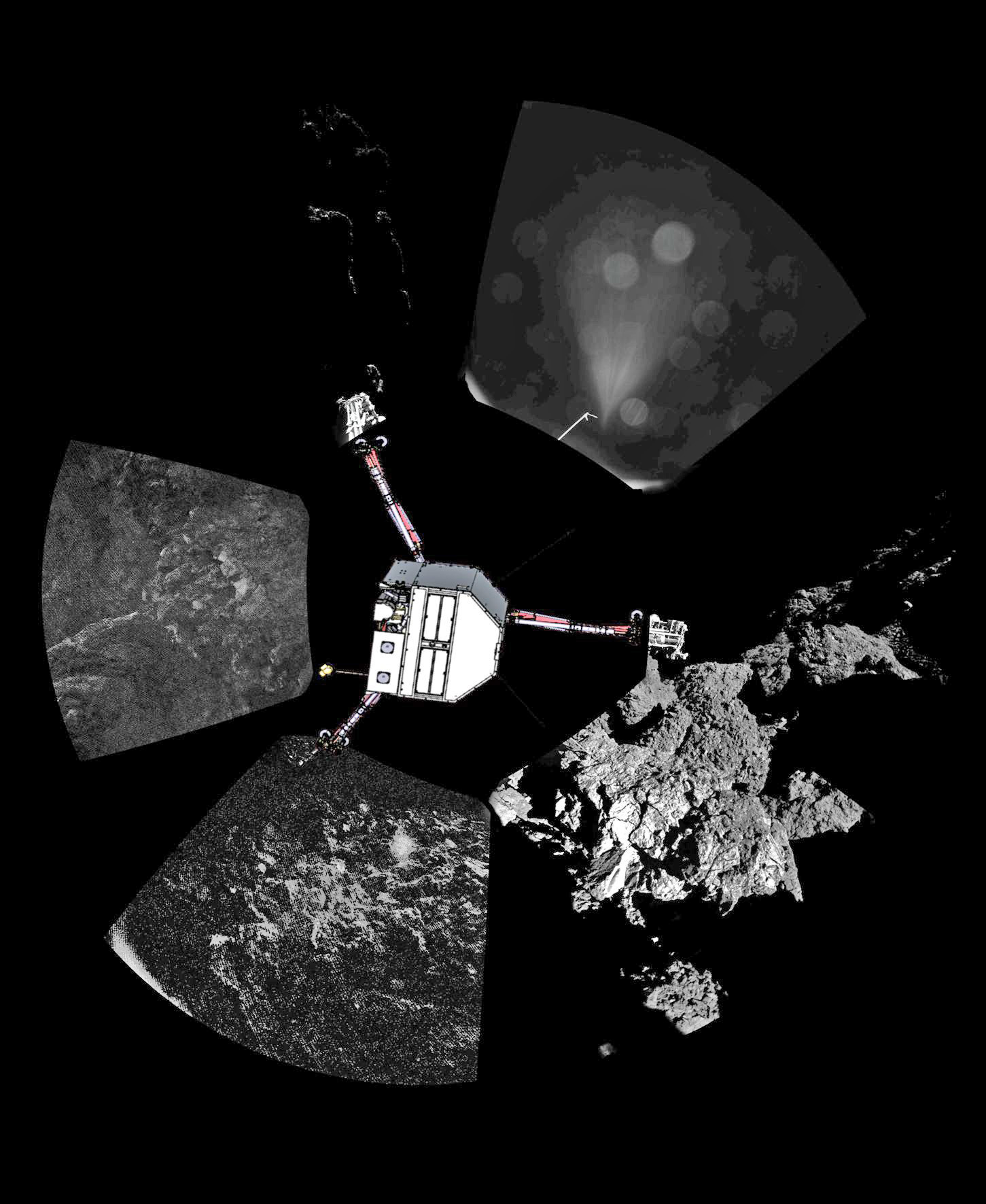
Marking a major triumph in human ingenuity, Europe’s Philae robotic probe touched down safely on the surface of a far-flung comet for the first time in human history, on Nov. 12, and successfully transmitted unprecedented science data after a gutsy 10-year journey through space.
Nothing like this audacious plan to orbit and land a spacecraft on the nucleus of an active comet has ever been attempted before.
Astonishingly, the tiny robot landed not once but actually three times, narrowly surviving two harrowingly unplanned bounces back into space before finally coming to rest fully intact astride a cliff on the target comet 67P/Churyumov–Gerasimenko, which is shaped like a rubber ducky.
And the 100-kg (220-pound) Philae lander not only landed undamaged, but successfully completed its primary science mission.
Unfortunately, when Philae finally stopped hopping around it came to rest in a shadowed spot next to a tall cliff that blocked most of the sunlight from reaching the solar panels, thus severely limiting its ability to generate new power from the life-giving solar arrays and sustain ongoing operations.
The onboard primary and secondary batteries were only designed to last 2.5 days. Energy from the solar panels is necessary to continue beyond.
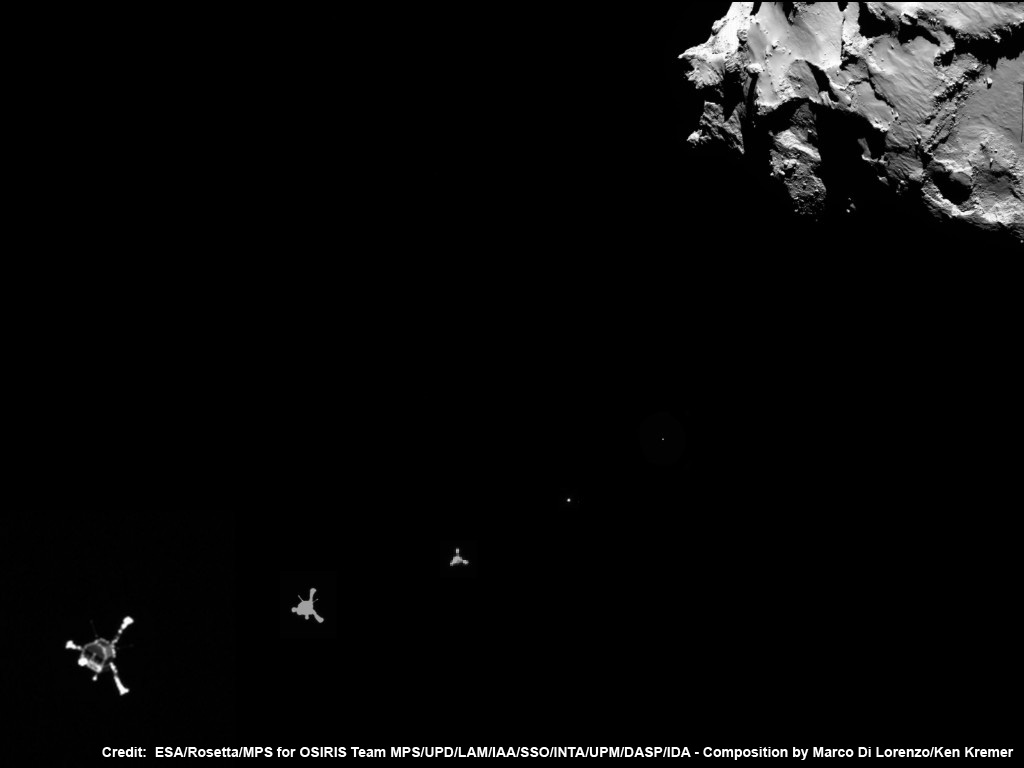
Nevertheless, it lasted nearly 57 hours and also successfully accomplished the first-ever research investigations from the surface of a comet and transmitted a full science data package before entering hibernation for an unknown period of time, after the on-board battery power was exhausted.
Since Philae had no landing thrusters or guidance, the entire triple landing sequence is nothing short of miraculous but surely enabled by outstanding engineering and science planning from the entire team for the history making Rosetta/Philla mission, developed and built by the European Space Agency (ESA), as well as some well=earned good luck.
“It has been a huge success, the whole team is delighted,” said Stephan Ulamec, lander manager at the DLR German Aerospace Agency, who monitored Philae’s progress from ESA’s Space Operations Centre in Darmstadt, Germany, all this week.
“Despite the unplanned series of three touchdowns, all of our instruments could be operated and now it’s time to see what we’ve got.”
The last transmission received via the Rosetta mothership occurred early Saturday CET/late Friday EST at 01:36 a.m. CET Nov. 15/7:36 p.m. EST Nov. 14.
“Prior to falling silent, the lander was able to transmit all science data gathered during the First Science Sequence,” says Ulamec.
“This machine performed magnificently under tough conditions, and we can be fully proud of the incredible scientific success Philae has delivered.”
In a last ditch bid to extend its life, engineers successfully commanded the lander to lift its body by about 4 centimeters and rotate some 35° to move the solar arrays to a position where they could receive a bit more solar energy.
But then, “Just as the last science data fed back to Earth, Philae’s power rapidly depleted.”
At its final landing site, the lander is only receiving about 1.5 hours of illumination per comet day versus the six hours of sunlight it would have received at Agilkia.
Image Caption: Philae’s first touchdown seen by Rosetta’s NavCam camera. This animated image provides strong evidence that Philae touched down for the first time almost precisely where intended. The animation comprises images recorded by the navigation camera (NAVCAM) on board Rosetta as the orbiter flew over the (intended) Philae landing site on 12 November. The images were taken about 5 min apart before and just after touchdown. Philae was approximately 250 m above the surface in the first image. The second image is 1 min 26 seconds after first touchdown. The touchdown is seen as a dark area, which is considered as strong indication that the lander touched down at this spot (possibly raising dust from the impact). Credits: ESA/Rosetta/NAVCAM – CC BY-SA IGO 3.0
The lander returned all of its housekeeping data, as well as science data from the targeted instruments, including ROLIS, COSAC, Ptolemy, SD2, and CONSERT. This completed the measurements planned for the final block of experiments on the surface, said ESA in a statement.
The ROLIS descent imagery showed that the surface of comet 67P is covered in dust and boulders ranging in size from a few millimetres to five meters and more.
Philae was delivered to comet 67P and the landing site by ESA’s Rosetta orbiter while the pair were traveling some 500 million kilometers (300 million miles) from Earth and moving at 41,000 mph on a mission of cutting-edge science to elucidate our origins.
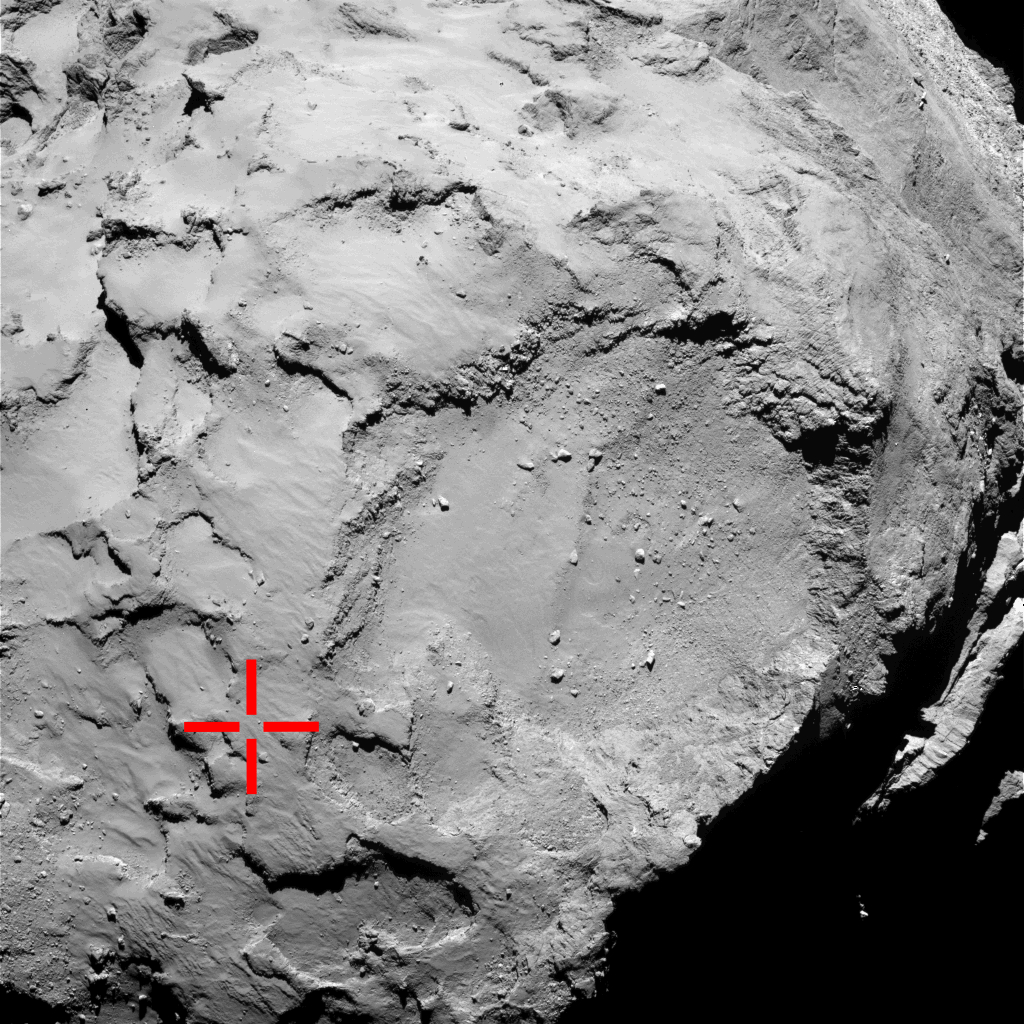
Although at first the touchdown at the chosen Agilkia landing site appeared to proceed precisely as planned, on Nov. 12 at about 16:03 GMT/17:03 CET/11:03 a.m. EST, during a live broadcast from ESA mission control at the European Space Operations Center (ESOC) in Darmstadt, Germany, the signals soon turned confusing and the team wasn’t certain as to the true situation.
Data was transmitted back by Philae to eagerly awaiting scientists, flight dynamics specialists, and engineers at the Lander Control Centre in Cologne, Germany, and the Philae Science, Operations and Navigation Centre in Toulouse, France. But it took some time to study and fully interpret this first-ever telemetry from a comet’s surface.
Finally the team came to the astonishing conclusion that Philae didn’t just touch down once on Comet 67P/Churyumov–Gerasimenko, but rather three times over a time span of several hours.
Comet 67P measures only 4 kilometers (2.5 mile) wide. Philae was targeted to land on the “head” of the bizarre two-lobed comet while it was rotating once about every 12.4 hours.
The landing was conducted in an entirely autonomous mode after being dropped off by Rosetta for a trip dubbed the “7 Hours of Terror.” It takes over 28 minutes for signals to reach Earth while travelling at the speed of light.
Upon landing, the vehicle was supposed to anchor itself to the comet’s surface by firing its set of two harpoons and engaging ice screws.
Despite initial positive indication, the harpoons did not fire as planned. Philae apparently rotated after the first touchdown and lifted off again, said Ulamec.
Philae touched the surface at 15:34, 17:25 and 17:32 GMT, Ulamec explained at an ESA Rosetta Google hangout on Nov. 14.
“The information was provided by several of the scientific instruments, including the ROMAP magnetic field analyser, the MUPUS thermal mapper, and the sensors in the landing gear that were pushed in on the first impact,” he reported.
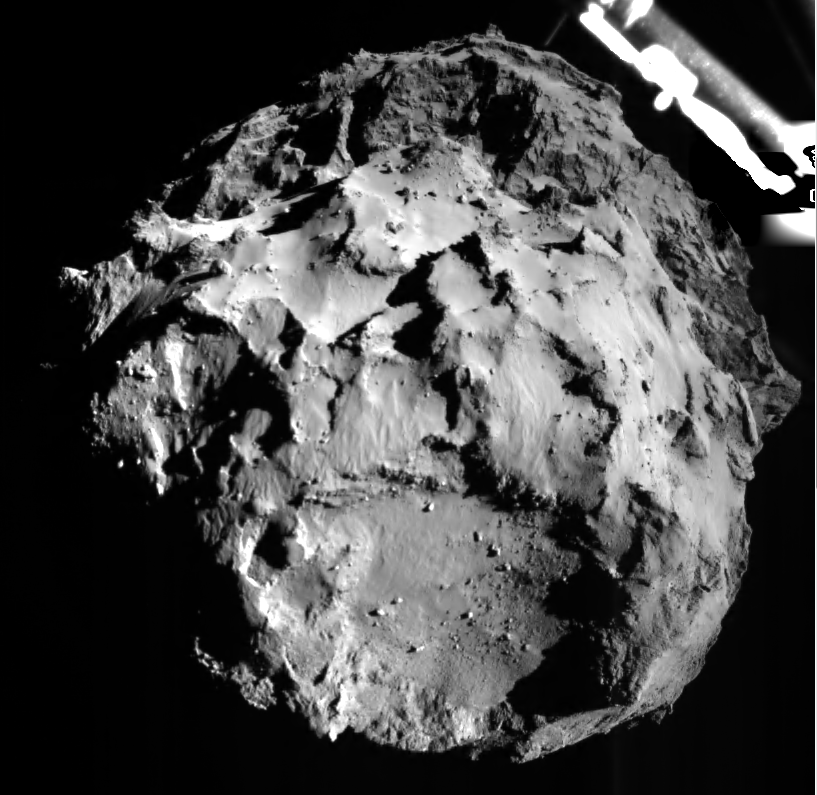
During the first bounce, the lander reached an altitude of about 1 kilometer and remained aloft for 1 hour 50 minutes. It also moved about 1 kilometer at a speed of 38 cm/s.
The second bounce was much smaller, travelling for some seven minutes at about 3 cm/s.
The team has determined that the initial touchdown occurred almost right in the middle of the predicted landing ellipse at Agilkia by examining images taken by the lander’s downward-looking ROLIS descent camera and coordinating those observations with more from the orbiter’s OSIRIS images to match features. See the animated GIF herein.
“The first touchdown was perfect and on flat land,” said Holger Sierks, principal investigator for Rosetta’s OSIRIS camera from the Max Planck Institute for Solar System Research in Gottingen, Germany, at the Google hangout.
Agilkia was only selected as the primary landing site about six weeks ago and after Rosetta and Philae arrived in early August. The landing site is only about 500 meters across.
The team is still trying to determine the final location of Philae using onboard data as well as imagery from Rosetta’s OSIRIS and navcam cameras.
Philae is believed to have set down somewhere in the “Site B” candidate landing site next to Agilkia, perhaps along a crater rim—also on the comet’s head—noted Rosetta project scientist Matt Taylor.
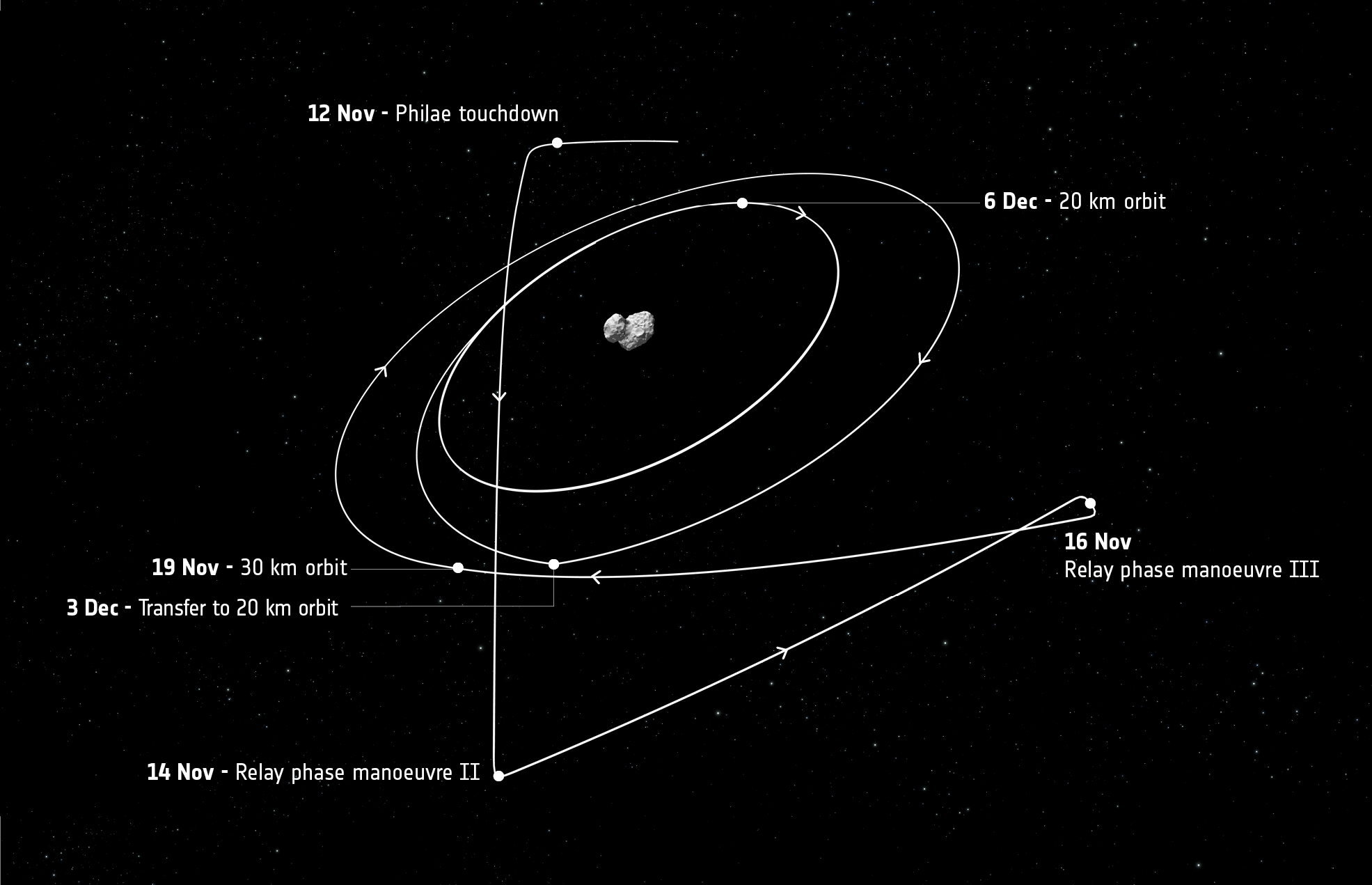
Although Philae has gone to sleep, engineers will regularly continue to listen for a signal and try to contact it.
The chances may improve further later in the mission, as the comet approaches closer to the Sun and illumination time increases.
“We still hope that at a later stage of the mission, perhaps when we are nearer to the Sun, that we might have enough solar illumination to wake up the lander and re-establish communication,” added Ulamec.
Additional communications slots are available today and in the future when Rosetta’s orbit bring it into line-of-sight visibility with Philae.
However, given the low recharge current coming from the solar panels at this time, it is unlikely that contact will be re-established with the lander in the near future, says ESA.
Meanwhile, Rosetta is moving back out gradually to a 30 kilometer orbit.
“It’s been a fantastic week. We started 20 years ago. Keep your fingers crossed for now and in the long term,” said an elated Ulamec.
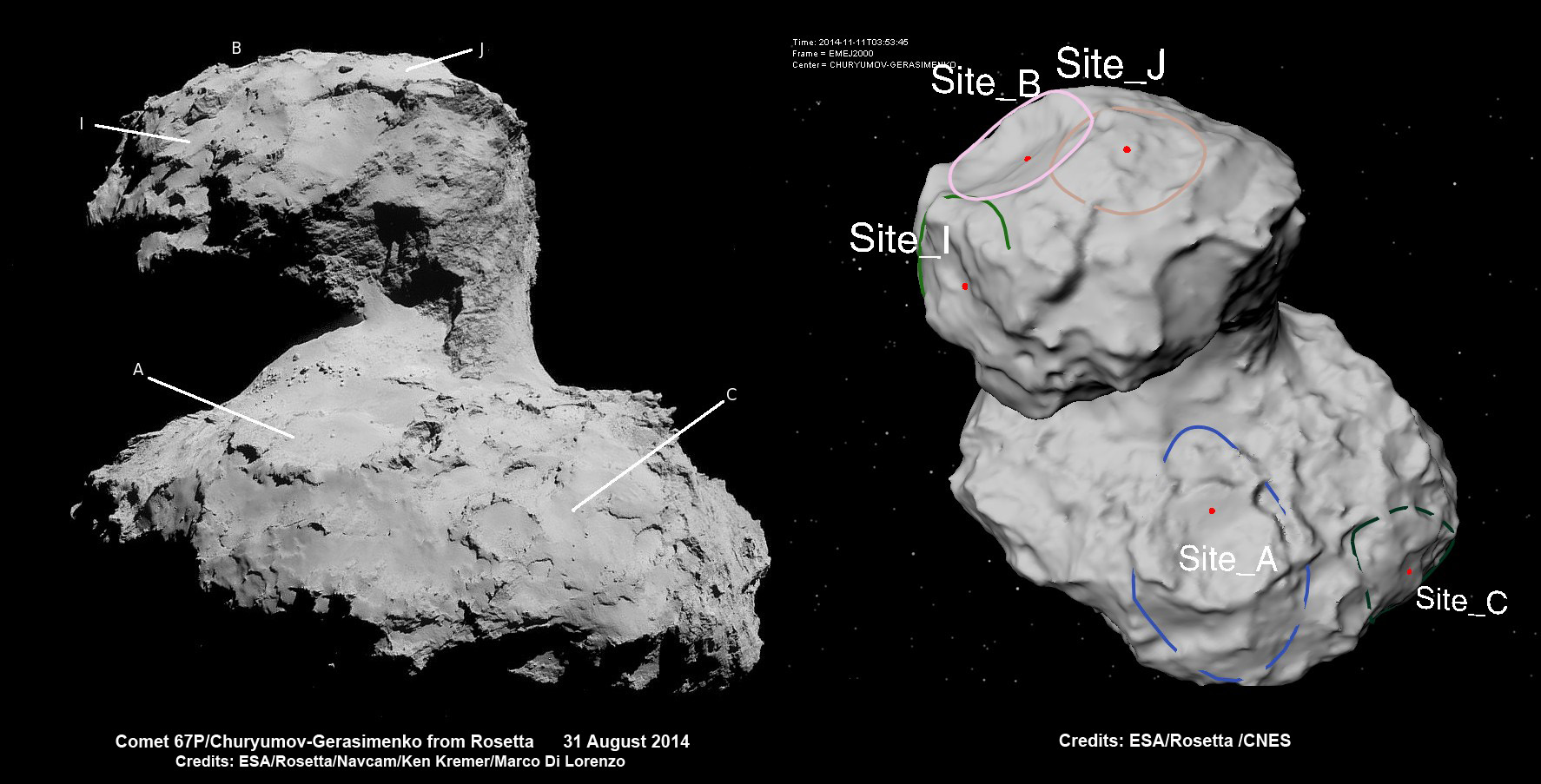
Stay tuned here for continuing developments.
Want to keep up-to-date with all things space? Be sure to “Like” AmericaSpace on Facebook and follow us on Twitter: @AmericaSpace
Missions » Rosetta »



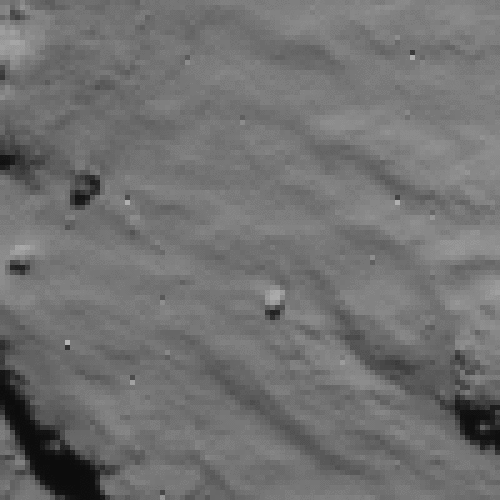
Mankind has yet again accomplished an historic achievement in space exploration. Congratulations to the entire Rosetta/Philae team. On to the Jupiter/Saturn moons! Don’t stop now.
she’s taking a break
ten years is a long journey
if she deceides to talk again
she’ll be heard, right